 Logo of Rulaizong | |
| Total population | |
|---|---|
| over 90,000 followers (According to its official website) | |
| Founder | |
| Miaochan | |
| Regions with significant populations | |
| Taiwan | |
| Religions | |
| Buddhism (self-claimed) | |
| Scriptures | |
| Three Holy Teachings, Compassionate Teachings from Miaochan, Dharma's Speeches towards Heredity, Heart Sutra and Diamond Sutra | |
| Website | |
| www |
Rulaizong has 30 monasteries in the northern, middle, and southern parts of Taiwan. Moreover, 101 university clubs related to Rulaizong were established in Taiwan. [9] For example, in the National Taiwan University, the "Buddhism Witness Club", which had the background of Rulaizong, organized band practices, exchanges, and pujas. [10] In 2015, the "Buddhism Witness Club" at the National Taiwan Ocean University was awarded the "Excellent Award in Academic and Art Clubs" by Evaluation of Nationwide University Clubs of Taiwan. [11] These clubs also cooperated with Taiwanese police to organize anti-crime promotion activities. [12]
According to its official website, Rulaizong has 90,000 believers, most of them intelligentsia and their families. [4] More than 8,000 university students are believers of Rulaizong. [13] Some Taiwanese artists, such as Sonia Sui, Yao Yao, Annie Yi, Harlem Yu, Joanne Tseng, and Chiang Shu-na are also believers of Rulaizong. Matthew Lien, a Taiwan-based Canadian artist, composed a song called "All Rise Together" for Rulaizong. When Chiang Shu-na participated in an activity organized by Rulaizong, she was blessed by Miaochan. At that time, her body shook for 20 seconds, making discussions in the Internet society of Taiwan. [14]
A person who is willing to become a believer of Rulaizong must be introduced by a believer in order to enter Rulaizong. A handbook is published for senior believers to answer newcomers' doubts. [2] According to Rulaizong's confidential documents, Rulaizong does not accept critically ill patients and children as believers. [2]
Controversies
According to the Shakyamuni Buddhist Foundation founded by Miaotian, Miaochan cheated his master, destroyed his reputation, and apprenticed privately. Hence, the Foundation gave a verbal warning to Miaochan in 2012. After the incident of Chiang Shu-na in 2014, the Foundation found that Miaochan also used sorcery to cheat people, misled people, and made trouble among believers. Consequently, the Foundation decided to expel Miaochan from Zen. [15] The Foundation also described the behavior of believers of Rulaizong, saying that using the phrase "Thank the Master, Praise the Master," which is repeated by believers during gatherings to praise Miaochan is like parroting. [15] The Foundation also stated that the activities of Rulaizong were a kind of idolatry, violating the concept that all sattvic beings are equal in Buddhism. [15]
Besides its doctrines, Rulaizong has been criticized for attracting believers in a direct marketing fashion. [2] Believers of Rulaizong must pay 300 New Taiwan dollars for admission, while students and other believers pay 200 New Taiwan dollars and 2000 New Taiwan dollars for the extra fee each month, respectively. Although the official position is that the extra fee is voluntary, it has led to controversy. [9] Moreover, a bank issued a credit card that frequently deducted an amount of cash to cover the extra fee, and deducted 1% from each transaction to the "Buddhism Witness Association". [9] According to an estimation by the Apple Daily , Rulaizong earned the accumulated revenue of a few billion New Taiwan dollars in 2014. [2]
University clubs related to Rulaizong were also involved in controversies. Some students accused these clubs of forcibly receiving revenue and occupying classrooms for promotions. [16] Some students from the National Taiwan Normal University said that they had to pay an extra fee of 200 New Taiwan dollars after they attended activities related to Rulaizong. Although the president of the club declined the accusation of the extra fee, according to the regulations of university clubs in Taiwan, these clubs were responsible to report other revenues besides the club fees. The club at the National Taiwan Normal University did not report the extra fees to the university, leading the university to launch an investigation. [17]
After the clip about Chiang Shu-na shaking for 20 seconds during an activity organized by Rulaizong was revealed, the Shakyamuni Buddhist Foundation criticized the behavior as the result of a strange power that made believers act crazy. [15] A psychologist said that Chiang's behavior was something like expressing emotions or hysteria. A religious expert said that it was irrelevant to induction. [18] An expert of qigong said that it was a way of hypnosis using qigong. [2]
Related Research Articles

Hsing Yun was a Chinese Buddhist monk, teacher, and philanthropist based in Taiwan. He was the founder of the Fo Guang Shan Buddhist monastic order as well as the layperson-based Buddha's Light International Association. Hsing Yun was considered a major proponent of Humanistic Buddhism and one of the most influential teachers of modern Taiwanese Buddhism. In Taiwan, he was popularly referred to as one of the "Four Heavenly Kings" of Taiwanese Buddhism, along with his contemporaries: Master Sheng-yen of Dharma Drum Mountain, Master Cheng Yen of Tzu Chi and Master Wei Chueh of Chung Tai Shan.
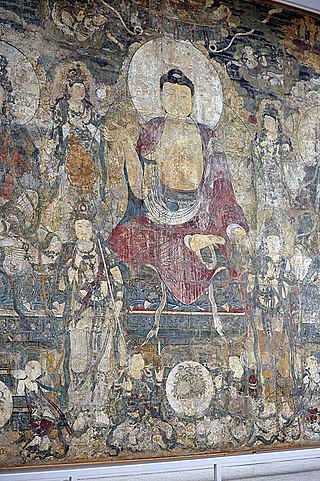
Bhaiṣajyaguru, or Bhaishajyaguru, formally Bhaiṣajya-guru-vaiḍūrya-prabhā-rāja, is the Buddha of healing and medicine in Mahāyāna Buddhism. Commonly referred to as the "Medicine Buddha", he is described as a doctor who cures suffering using the medicine of his teachings.
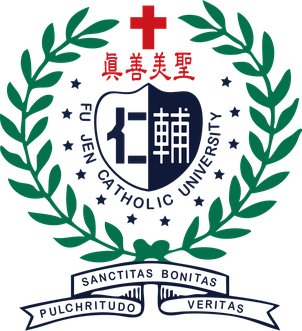
Fu Jen Catholic University is a private Catholic university in Xinzhuang, New Taipei City, Taiwan. The university was founded in 1925 in Beijing at the request of Pope Pius XI and re-established in Taiwan in 1961 at the request of Pope John XXIII, its name means "assistance" and "benevolence". Fu Jen has since grown to comprise twelve colleges and schools, among which are several Taiwan's first or only academic units, such as Italian language, info-management, museology, religious studies, philosophy as well as hosts the earliest A&HCI journal in the whole country. The campus is served by Fu Jen University Station, Taiwan's first metro station named after a university.

Ākāśagarbha is a bodhisattva in Chinese, Japanese and Korean Buddhism who is associated with the great element (mahābhūta) of space (ākāśa).
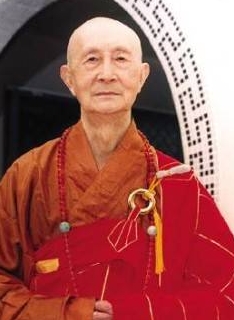
Yin Shun was a Chinese Buddhist monk and scholar in the tradition of Chinese Mahayana Buddhism. Though he was particularly trained in the Three Treatise school, he was an advocate of the One Vehicle as the ultimate and universal perspective of Buddhahood for all, and as such included all schools of Buddha Dharma, including the Five Vehicles and the Three Vehicles, within the meaning of the Mahayana as the One Vehicle. Yin Shun's research helped bring forth the ideal of "Humanistic" (human-realm) Buddhism, a leading mainstream Buddhist philosophy studied and upheld by many practitioners. His work also regenerated the interests in the long-ignored Āgamas among Chinese Buddhist society and his ideas are echoed by the American Theravadin teacher Bhikkhu Bodhi. As a contemporary master, he was most popularly known as the mentor of Cheng Yen, the founder of Tzu-Chi Buddhist Foundation, as well as the teacher to several other prominent monastics.
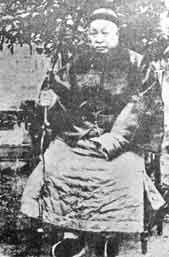
Yang Wenhui was a Chinese lay Buddhist reformer who has been called "The Father of the Modern Buddhist Renaissance". His courtesy name was Rénshān (仁山). He was a native of Shídài (石埭) county in Anhui province.

Buddhism is one of the major religions of Taiwan. Taiwanese people predominantly practice Mahayana Buddhism, Confucian principles, Taoist tradition and local practices. Roles for religious specialists from both Buddhist and Taoist traditions exist on special occasions such as for childbirth and funerals. Of these, a smaller number identify more specifically with Chinese Buddhist teachings and institutions, without necessarily eschewing practices from other Asian traditions. Around 35% of the population believes in Buddhism.

Pure Land is the concept of a celestial realm of a buddha or bodhisattva in Mahayana Buddhism where many Buddhists aspire to be reborn in.

Myōken, also known as Sonjō-Ō, is a Buddhist deification of the North Star worshiped mainly in the Shingon, Tendai and Nichiren schools of Japanese Buddhism.
The Sanjiejiao or Pufazong was a religious movement based on the teachings of the Chan Buddhist monk Xinxing.

Tiantong Temple is a Buddhist temple located in Taibai Mountain of Yinzhou District, Ningbo, Zhejiang, in the People's Republic of China. The temple covers a total area of 76,400 square metres (822,000 sq ft), with more than 38,800 square metres (418,000 sq ft) of floor space. Tiantong Temple is listed as one of the "Five Chan Buddhism Temples". Tiantong Temple is the cradle of the Sōtō school of Japanese Buddhism.
Du Qiong, courtesy name Boyu, was an official, astronomer and diviner of the state of Shu Han in the Three Kingdoms period of China.

The Yunlin County Tuku Junior High School is a junior high school located in Tuku, Yunlin, Taiwan, which has two kinds of special classes - Chinese music class and PE class.
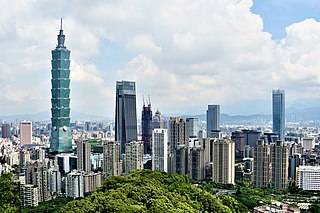
In Taiwan, the North–South divide refers to the uneven distribution of resources in regard to political, wealth, medical, economic development, education and other aspects across the country over past decades that has drawn the social and cultural differences between Northern Taiwan and Southern Taiwan today.

Temple of King Ashoka is a Buddhist temple located in Yinzhou District of Ningbo, Zhejiang, China.
Philosophy in Taiwan is the set of philosophical traditions in Taiwan, while Taiwanese philosophy is taken to mean philosophical work from the country. Philosophical thought in Taiwan is diverse, drawing influence from Chinese philosophy during Qing rule from the 17th and 18th century, and Western philosophy through the Kyoto School during Japanese rule in the 19th and early 20th century. Taiwanese philosophy took a more endogenous turn during the modern era, with burgeoning philosophical debate regarding Taiwanese Gemeinschaft.
China Lutheran Seminary is an independent theological school, graduate school, and seminary, located in Hsinchu City, Taiwan. Founded in 1966, the seminary is Lutheran in tradition and practice.
Events in the year 2022 in China.
Chen Ren-he(陳仁和)(1922—1989), a native of Jibei, Penghu, is one of the few architects studied in Japan and is also one of the first generation of architects in post-war Taiwan.
References
- 1 2 3 邱曉佩; 劉亮亨 (2014-03-07). "妙禪師父何人?早年替身演員 結3次婚". 中時電子報. Archived from the original on 2014-03-07. Retrieved 2015-12-23.
- 1 2 3 4 5 6 方翊倩 (2014-04-02). "直銷式收信徒 江淑娜師父揭祕". 台灣蘋果日報. Archived from the original on 2015-12-24. Retrieved 2015-12-24.
- ↑ 龔祐吟 (2014). 實相無相的禪宗實踐:妙天的思想內涵與相關議題 (PDF) (Thesis). 國立交通大學. Archived (PDF) from the original on 2015-12-24. Retrieved 2015-12-24.
- 1 2 3 "關於妙禪師父". 佛教如來宗. Archived from the original on 2016-01-15. Retrieved 2016-01-15.
- ↑ "妙禪師父立「佛教如來宗」帶領弟子成就佛道". 佛教如來宗. Archived from the original on 2016-01-16. Retrieved 2016-01-16.
- ↑ "妙禪師父開示三聖教". 佛教如來宗. Archived from the original on 2016-01-15. Retrieved 2016-01-15.
- ↑ "入「寶山」不要空手回! 妙禪師父慈悲開示: 入明師座下 不要只想給 師父渡業力 應依教奉行 佛心印心 成佛利眾". 佛教如來宗. Archived from the original on 2016-01-16. Retrieved 2015-12-27.
- 1 2 "妙禪師父慈悲開示:通過如來法則·由如來親定". 佛教如來宗. Archived from the original on 2016-01-16. Retrieved 2015-01-16.
- 1 2 3 宋燕旻; 戴榮賢; 姜竹祥 (2014-03-05). "妙禪信徒遍全台 每月繳交護持金". 華視新聞網. Archived from the original on 2015-12-23. Retrieved 2015-12-24.
- ↑ "如來實證社". 國立台灣大學課外活動組. Archived from the original on 2016-02-18. Retrieved 2015-02-18.
- ↑ "海大社團表現佳 全國評鑑再度獲特優肯定". 中央社. 2015-04-08. Archived from the original on 2015-12-25. Retrieved 2015-12-24.
- ↑ 許國楨 (2012-06-24). "〈中部〉校園防詐宣導 佛學社淡定易教". 自由時報. Archived from the original on 2015-12-25. Retrieved 2015-12-25.
- ↑ "佛教如來宗大學團與如來實證社簡介". 佛教如來宗. Archived from the original on 2015-12-26. Retrieved 2015-12-26.
- ↑ "江淑娜 虔心妙禪暴哭激晃 抖出信徒 瑤瑤 隋棠". 台灣蘋果日報. 2014-03-06. Archived from the original on 2015-12-25. Retrieved 2015-12-24.
- 1 2 3 4 "禪宗紀律委員會決議公告". 財團法人釋迦牟尼佛救世基金會. 2014-03-11. Archived from the original on 2015-12-25. Retrieved 2015-12-24.
- ↑ "曾跟隨妙天 妙禪自立門戶擁7萬信眾". TVBS新聞. 2014-03-05. Archived from the original on 2016-01-05. Retrieved 2015-12-27.
- ↑ "〈獨家〉月收200「隨喜費」? 大學宗教社惹爭議". TVBS新聞. 2012-03-30. Archived from the original on 2015-12-25. Retrieved 2015-12-25.
- ↑ 【中視新聞】江淑娜篤信妙禪 全身抖動痛哭影片瘋傳 20140305. 中視新聞. 2014-03-04. Retrieved 2015-12-24.
External links
Text is available under the CC BY-SA 4.0 license; additional terms may apply.
Images, videos and audio are available under their respective licenses.
| Rulaizong | |||||||||
|---|---|---|---|---|---|---|---|---|---|
| Traditional Chinese | 佛教如來宗 | ||||||||
| Simplified Chinese | 佛教如来宗 | ||||||||
| Literal meaning | The Tathāgata Sect of Buddisum | ||||||||
| |||||||||